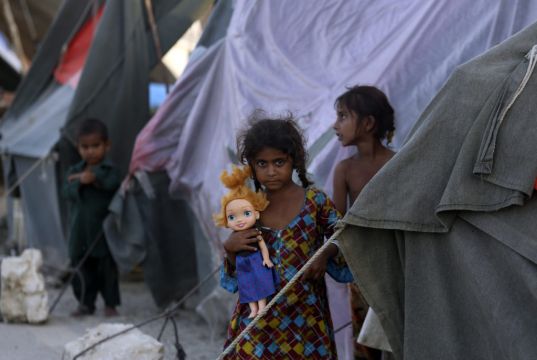Planes carrying fresh supplies have arrived in flood-ravaged Pakistan as the death toll from the disaster surged past 1,200, officials said.
The ninth flight from the United Arab Emirates and the first from Uzbekistan were the latest to land in Islamabad overnight as a military-backed rescue operation elsewhere in the country reached more of the three million people affected by the flooding.
Multiple officials blamed the unusual monsoon and flooding on climate change, including UN Secretary-General Antonio Guterres, who earlier this week called on the world to stop “sleepwalking” through the environmental crisis.

Pakistan’s foreign ministry said that the planes brought food, medicine and tents. The country’s Prime Minister Shahbaz Sharif had planned to travel to UAE on Saturday, but has postponed the trip to visit flood-hit areas at home.
So far, Pakistan has received aid from China, Saudi Arabia, Qatar, Turkey, Uzbekistan, UAE and some other countries. This week, the United States also announced to provide aid worth 30 million dollars (£26 million) for the flood victims.
Pakistani officials blame climate change for the recent heavy monsoon rains that triggered floods.
Asim Iftikhar, the spokesman at foreign ministry, said at a news briefing the previous day that the crisis has lent credibility to climate change warnings from scientists.
“This is not a conspiracy, this is a reality and we need to be mindful,” he said.
Urgent appeal for the floods in Pakistan❗
The @UN and the @GovtofPakistan call for $160.3M to provide relief to at least 5.2M people in need after the worst floods in recent history hit the country.
Read more: https://t.co/4GpZcpM7em#PakistanFloods2022 #ClimateCrisis pic.twitter.com/qMTPaXTZoB— UN Humanitarian (@UNOCHA) August 30, 2022
According to initial government estimates, the devastation has caused 10 billion dollars (£8.6 billion) of damage.
Since 1959, Pakistan has emitted about 0.4% of heat-trapping carbon dioxide, compared to 21.5% by the United States and 16.4% by China, according to scientists.
Pakistani officials and experts say there has been a 400% increase in average rainfall in Pakistan’s Baluchistan and Sindh areas, which led to the extreme flooding.
Earlier this week, the United Nations and Pakistan jointly issued an appeal for 160 million dollars (£138 million) in emergency funding to help the 3.3 million people affected by floods that have affected more than one million homes.

On Friday, authorities were warning people in the district of Dadu in the southern Sindh province to move to safer places ahead of floodwater from the swollen Indus river that is expected to hit the region this week.
In May, some parts of Sindh were the hottest place in Pakistan. Now people are facing floods there that have caused an outbreak of waterborne diseases. Although flood waters continued to recede in most of the country, many districts in Sindh remained underwater.
Farah Naureen, the director for Pakistan at the international aid agency Mercy Corps, told The Associated Press that around 73,000 women will be giving birth within the next month, and they needed skilled birth attendants, privacy, and birth facilities. Otherwise, she said, the survival of the mother and the newborn will be at risk.
According to the military, rescuers backed by troops have resumed rescue and relief operations.
Rescuers are mostly using boats, but helicopters are also flying to evacuate stranded people from remote flood-hit towns, villages and districts across Pakistan areas, as well as delivering food.







